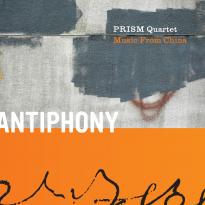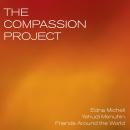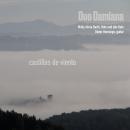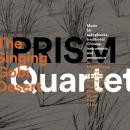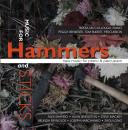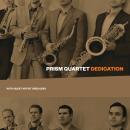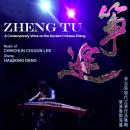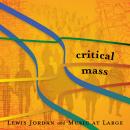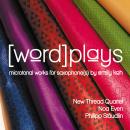Antiphony
Antiphony
Philadelphia, PA
| AntiphonyiTunes Artist's PageiTunes Album Page | |||
|---|---|---|---|
| Song Title | Time | Price | |
| 1. | Songs: I. Pastorale | 07:24 | $0.99 |
| 2. | Songs: II. Crescent Moon at Dawn | 05:27 | $0.99 |
| 3. | Antiphony | 17:20 | |
| 4. | Yuan | 14:53 | |
| 5. | Septet | 11:54 | |
| 6. | Shuang Que | 08:47 | $0.99 |
| 7. | Chinatown: I. Strangers | 02:28 | $0.99 |
| 8. | Chinatown: II. Footprints | 02:34 | $0.99 |
| 9. | Chinatown: III. Festival | 02:16 | $0.99 |
Since the Renaissance, ‘antiphony’ normally refers to performers separated in space, tossing musical phrases back and forth to dramatic effect. Rarely does it connote a gap between distant continents and musical languages. In this new recording, music and musicians from China, New York and Philly coalesce in one of the most unexpected collaborations the global village has yet produced.
In Antiphony, Music from China – a New York-based, world-class ensemble of adventurous virtuosos on traditional Chinese instruments (think Erhu, Pipa, bendy strings and fighting percussion) – encounters its sonic antithesis: the pure, brassy, reedy, oh-so-Western saxophone. Not just one, but four of them. In the hands of the daring New-York-and-Philly-based PRISM Quartet, though, the musical conversations are anything but stilted first dates.
The agenda for this musical summit is set by six first-rank composers of Chinese origin, familiar with both their own millennium-old ensemble tradition and Adolphe Sax’s 19th-century invention, born in the industrialized West. Among them are three members of the celebrated “class of ’78” – Tan Dun, Chen Yi, and Zhou Long – composers who emerged from the wilderness of the Cultural Revolution to forge new a musical language, integrating Chinese and Western traditions in deeply personal ways.
Combining ancient and modern themes, Academy-Award winner Tan Dun’s work takes a duet for bowed and struck string instruments (Erhu and Yanqin) in a totally new direction. Chen Yi’s Septet reflects the dancing, flowing exuberance of the ancient murals in the Mogao Caves. Zhou Long’s dense and intricate piece features percussion as the driving force carrying the ensembles along to compelling climaxes. Wang Guowei is known as a star performer on the bowed fiddles; his work unites the string and sax timbres through their shared ability to mimic vocal nuances and rhetoric. Lei Liang’s piece is inspired by the true story of a woman who wailed like a ghost each night in order to raise awareness of injustice during the Cultural Revolution. Finally Ming-Hsiu Yen reminds us that Chinatown USA is where all these traditions meet and share a good time.
We come away from Antiphony amazed at the world’s vast history and ability to absorb such a range of flavors to the satisfaction of the heart, brain and belly.
Music from China is a musical organization, founded in 1984, whose mission is to promote both traditional and new music and whose reach has become international. Led by Susan Cheng, Wang Guowei (who has taught at Wesleyan University) and Zhou Long, the chamber ensemble has premiered over 100 works by Chinese composers, many of which were either commissioned or competition prizewinners.
This stunning CD opens with Wang Guowei's 2-movement "Songs for Huqin and Saxophone Quartet" - the first part, "Pastorale", blends the open feeling of Aaron Copland's best works with the softness of a Mongolian folk melody (supplied by the composer on zhonghu, a Chinese fiddle. Part 2, "Crescent Moon at Dawn" is derived from a Chinese folk tune with Guowei on banhu (another style of Chinese fiddle). The plaintive melody moves among the saxophones and, at other times, they serve as a chorus supporting the melody lines. The closing section of the tune hops along like a Far Eastern hoedown. The title track, composed by Zhou Long, is a series of small dialogues, first between the Chinese instruments and percussion - many stretches of silence separate the melody lines. The saxophone quartet enters 1/3rd of the way through the piece, serving as a bridge between the first and second sections. Guowei's haunting erhu (a 2-stringed fiddle) enters into a conversation with the saxophones, the lovely soprano tones bending above the string tones. The rousing closing section features a pounding martial beat underneath the whirling and whinnying reeds and strings. All but one of the pieces are recent compositions. The exception, "Shuang Que", is a 1984 work by Tan Dun (who is, perhaps, best known, for his Oscar winning score for "Crouching Tiger, Hidden Dragon") and does not feature the saxophones. Performed by Guowei on erhu and Li Liqun on yanggin (Chinese hammered dulcimer), the piece starts very quietly and, through a series of repeated melodic phrases, builds to a powerful finish. Most impressive is how the sound of the saxophones blend into these pieces. The music allows them space and they often carry the melody - in fact, Lei Liang's "Yuan" features only the saxophones and the piece has echoes of the work of American composers Roscoe Mitchell and the late Julius Hemphill. "Antiphony" (a musical term meaning " responsive singing or chanting") shows the power of cultural collaborations, not so much "East meets West" but really modern music that blends old instruments and melodies with current ideas of harmony.
- Richard B. Kamins, Step Tempest
